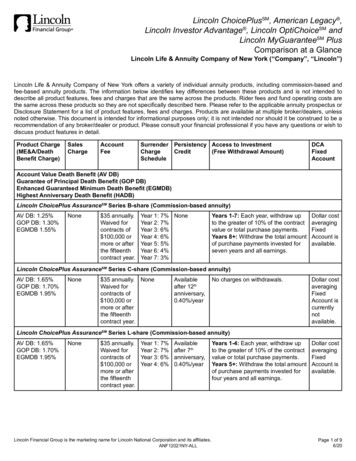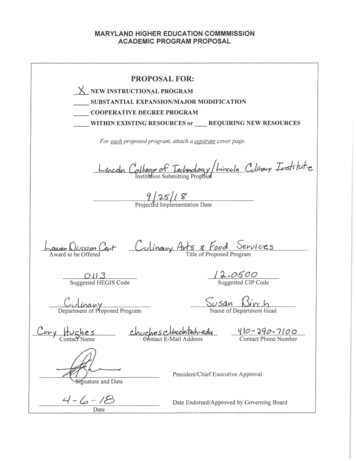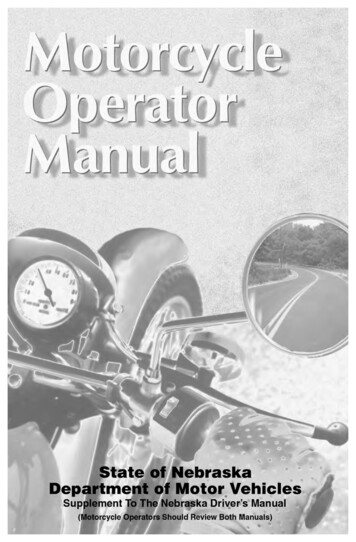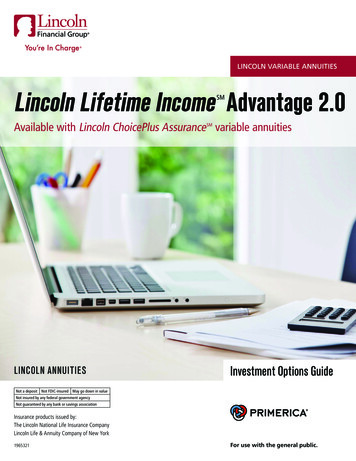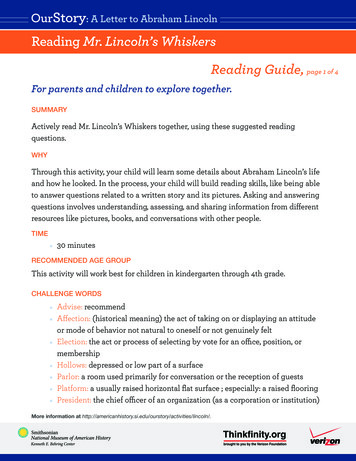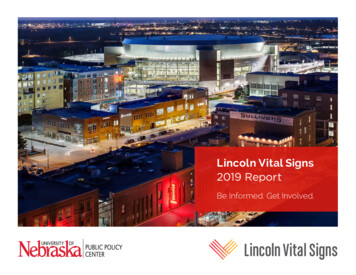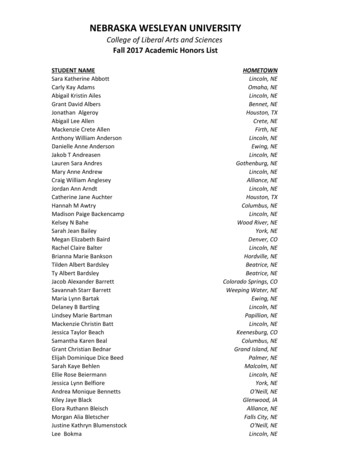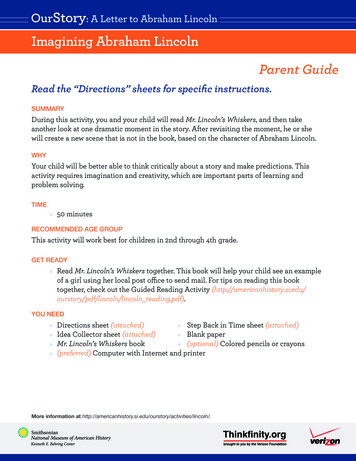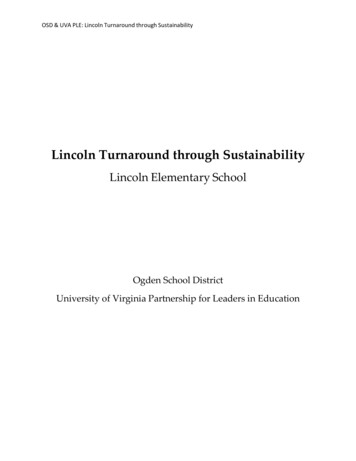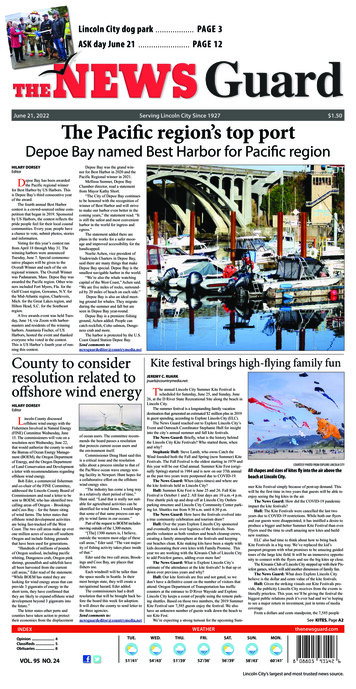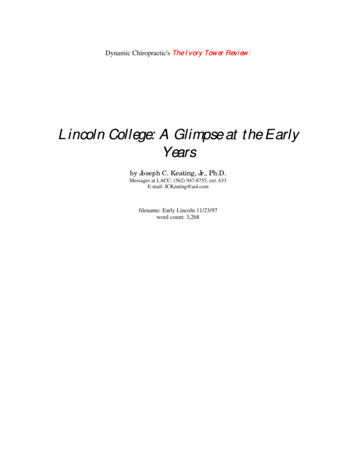
Transcription
Dynamic Chiropractic's The Ivory Tower Review:ReviewLincoln College: A Glimpse at the EarlyYearsby Joseph C. Keating, Jr., Ph.D.Messages at LACC: (562) 947-8755, ext. 633E-mail: JCKeating@aol.comfilename: Early Lincoln 11/23/97word count: 3,268
Keating2Lincoln College: A Glimpse at the Early YearsFor 45 years, from 1926 to 1971, it was admired as one of the academically strongestinstitutions of learning in the profession. Formed in the turbulent aftermath of B.J. Palmer, D.C.’sintroduction of the neurocalometer (NCM), the Lincoln Chiropractic College eventually dissolvedinto the National College of Chiropractic, its name retained in derivative forms, such as theNational-Lincoln School of Postgraduate Education (Beideman, 1995, p. 137) and theindependent Lincoln College Education & Research Fund, Inc. (contact: Edward L. Maurer,D.C., D.A.C.B.R., 2330 Gulf Road, Kalamazoo MI 49001 USA). The story of this proudinstitution’s formation and early operations (Stowell, 1983) merits consideration.The founding fathers ofthe Lincoln were well knownto the profession. All weregraduatesSchoolofofthePalmerChiropractic(PSC): Harry E. Vedder,D.C. (1910); James Firth,D.C.(1912);StephenJ.Drs. Firth, Vedder & Burich, circa 1920 at the PSCBurich, D.C. (1913); andArthurHeinrichs,D.C.(whose namewas later changed to Hendricks) (1920).Each had earned a reputation as an outstandinginstructors of the PSC, and each was considered a “core” faculty member. They often lectured atstate and national conventions, and frequently contributed to the chiropractic literature. Since thePSC had produced the overwhelming majority of DCs then in practice, a majority of chiropractorshad known one or more of these men as mentors before the Lincoln Chiropractic College’s(LCC’s) formation.Harry Vedder, who had little more than a high school education when he enrolled at theDavenport mecca, became an instructor in physiology. He authored such works as Textbook onChiropractic Physiology, Textbook on Chiropractic Gynecology and Chiropractic Advertising.
Lincoln College: A Glimpse at the Early YearsKeating3Stephen J. Burich, a graduate of Beloit College, taught chemistry in the public school systembefore taking up his new profession. B.J. Palmer considered him the “final authority on matterspertaining to the nervous system” (Rehm, 1980, p. 288). Burich authored Textbook ofChiropractic Chemistry, and with Firth and Vedder, co-authored a manual of adjustivetechniques. James Firth was a graduate of the Arenac County Normal College, and had beenemployed as a grade school teacher and principal before studying at Palmer. He joined he facultyin 1911, where he taught palpation and nerve tracing, physiology and symptomatology. Duringhis tenure at the “Fountain Head,” he authored Textbook on Chiropractic Symptomatology (laterretitled Chiropractic Diagnosis). Arthur Hendricks was a business school graduate before hisenrollment in the U.S. Navy during World War I. He earned his doctorate at the PSC in 1920,and immediately joined the faculty, where he taught anatomy, orthopedy, gynecology anddiagnosis (Rehm, 1980, p. 305).In August, 1924, B.J. Palmer formally introduced his two-pronged, spinal-heat sensing device,the NCM, by which, he claimed, subluxations could be detected more accurately than by anyother means (Keating, 1991). BJ asserted that in the future, any DC practicing without an NCMand without the NCM-training offered by the PSC must be considered unethical (Keating, 1997b,p. 207), and a danger to the public. Although Palmer claimed the strong support of his entirefaculty (Keating, 1997b, p. 217) for his new instrument and the terms of its lease to members ofthe profession ( 2,200 for a ten-year lease; mandatory minimum charge of 10 for an NCMreading), private correspondence (Thompson, 1931) suggests that BJ may have twisted their armsa bit in order to get their endorsements. Stowell (1983, 1990) suggests that BJ’s imposition oftheory (NCM, HIO) upon his faculty, a violation of their academic freedom, may have had muchto do with their departure from the PSC. Although some uncertainty about the precipitatingfactors exists (Keating, 1990; Quigley, 1990; Stowell, 1990), it seems clear that the birth of theLincoln was a consequence of BJ’s actions.
Lincoln College: A Glimpse at the Early YearsKeating4In the aftermath of the NCM’s introduction, the firstsignificant loss from the Palmer faculty was E.A. Thompson,D.C., who had headed the PSC’s Spinography Department forseveral years.Thompson relocated to Baltimore andestablished a practice; in later years he served on the LincolnCollege’s board of trustees.Firth’s departure from Davenport to establish a practice inChicago was announced in October, 1925 (Personals, 1925); healso lectured for a few months on behalf of his former pupil,Leo Spears, D.C. of Denver. Some six months after Firth’sErnest A. Thompson, D.C., circa1919departure from Iowa, Drs. Burich and Vedder also left the PSC(With, 1926). After briefly considering the possibility of establishing their new institution in Denver (Cleveland, 1926), the foursome of Firth, Vedder, Burichand Hendricks decided upon Indianapolis.In August, 1926, the newly established, non-profit LCC was chartered, with Vedder servingas president of the four-man administration and faculty. Classes commenced on September 20 inrented space on the second floor of the Lumberman’s Insurance Building in Indianapolis (Lincoln,1927, 1929; Stowell, 1983). The first class graduated on 16 March 1928 (Our, 1928). The initialcurriculum (see Table 1) involved 2,210 hours of instruction, which was probably not different inlength from that of the PSC (18 months). By 1929 an elective, four-year curriculum becameavailable, and in 1942, when the National Chiropractic Association’s (NCA’s) educationalstandards required it (Gibbons, 1985; Nugent, 1941), the four-year program became mandatory(Stowell, 1983). The new school also soon developed a post-graduate program of instructionthat was well-received by the profession, both nationally and internationally (Foreign, 1929; Post,1929). Straight chiropractor Joshua N. Haldeman, D.C., a 1926 PSC alumnus, regularly attendedLincoln’s summer offerings, where he earned certificates in “Physical Diagnosis, Dietetics,Transillumination, Urinalysis and the Technic of Scientific Spinal Correction” (Keating &Haldeman, 1995).Table 1: Initial curriculum of the Lincoln Chiropractic College of Indianapolis, 1926 (based on Stowell, 1983)
Lincoln College: A Glimpse at the Early YearsCoursesHoursAnatomyPhysiologyPathology & bacteriologyChemistry & urinalysisHygiene & public ursSymptomatology (including x-ray)Principles & practiceDieteticsOffice conduct & jurisprudenceEthics & first aidTotal:536.25487.5075.0048.7548.752,210.00From its outset, the LCC made a strong commitment to diagnostic training and the basicsciences, which was not at all surprising given the strengths of the founders. Instruction indietetics was part of the training, but physiotherapy was not. The Lincoln College declared itsstand on what BJ considered mixing, and characteristically demonstrated tolerance:.The Lincoln College never has, does not now, nor has it any intention of teachingPhysiotherapy, although we do stress Diet, and Diagnosis. We feel that we have our hands full inteaching Chiropractic. As we have repeatedly stated, we feel that the use of adjuncts by theChiropractor is a personal matter which he should be permitted to decide in his own practicewithout being subject to ridicule or condemnation. (Foreword, 1928)The LCC’s commitment to what its founders considered legitimate, straight chiropracticarrived just as Palmer, unsuccessful in his bid for re-election as secretary of the UniversalChiropractors’ Association, established the Chiropractic Health Bureau (forerunner of today’sICA). Lincoln’s founders expressed their concerns over the feuding within the profession:The Lincoln Chiropractic College assumes the position that the continuance of strife betweenthe straight Chiropractor and the mixer so effectively saps our energy, depletes our resources andscatters our forces that if long continued it will lead to the obliteration of the profession as amovement (Tolerance, 1927).Palmer graduate Carl S. Cleveland, Sr., D.C., whose own small school in Kansas City wasthen in its fourth year, urged Palmer to be calm over this development. He suggested thatLincoln’s founders “have their followers and will run a good school, with just a little too much ofa tendency towards analyzing effects rather than causes” (Cleveland, 1926). Palmer was furious(Moore, 1995), but his attitudes toward a broader scope practice for chiropractors wereapparently not representative of the field. A survey conducted by Lincoln College revealed thatmany DCs had moved beyond the strict definitions of chiropractic that BJ preferred (see Table 2).Table 2: Findings of a survey of chiropractors conducted by the Lincoln Chiropractic College (Turner, 1931, pp.208-11); schools from which chiropractic respondents graduated are not know to this writer, but presumably asubstantial percentage of Palmer graduates were includedChiropractors’ responses:QuestionsYesNo%NoTotal N
Lincoln College: A Glimpse at the Early Years1. Is your examination confined to the spine?2. Do you question your patients about subjective symptoms (abnormal symptoms)?3. Do you investigate objective symptoms (through inspection, palpation, percussion,auscultation, etc., other than the spine)?4. Do you examine the heart and pulse?5. Do you employ a spinal meter instrument (either resistance type or thermo-coupletype)?6. Do you use any of the various types of “radionics” equipment?7. Do you take the blood pressure?8. Do you use the clinical thermometer?9. Do you employ urinalysis?10. Do you advise your patients as to diet?11. Do you advise as to exercise, habits, etc.?12. Do you employ massage?13. Do you use a vibrator?14. Do you employ a heat lamp?15. Do you employ radionics?16. Do you use “light therapy”?17. Do you employ any form of “electro-therapy”?18. Do you employ any form of “hydro-therapy” (baths, enemas, colonic irrigation,etc.)?19. Do you practice “foot correction”?20. Do you give spinal adjustments to every case?21. Do you favor chiropractic schools teaching diagnostic methods?22. Do you favor chiropractic schools teaching “light therapy”?23. Do you favor chiropractic schools teaching “hydro-therapy”?24. Do you favor chiropractic schools teaching “electro-therapy”?25. Do you favor chiropractic schools teaching “radionics”?26. Do you favor chiropractic schools teaching massage?27. Do you favor chiropractic schools teaching “foot correction”?28. Do you favor chiropractic schools teaching 17861642180518001861
Lincoln College: A Glimpse at the Early YearsKeating7
Lincoln College: A Glimpse at the Early YearsKeating8Lincoln College commenced publication of its own magazine in 1927, and attractedmanuscripts from a number of prominent DCs, among them Stanley Hayes, D.C., editor of theBulletin of the West Virginia Chiropractors' Society, John Monroe, A.M., D.C., chairman of theACA's Bureau of Research and former PSC radiologist, E.A. Thompson, D.C. of Baltimore. By1929 the Lincoln Bulletin could claim a circulation of more than 6,000 readers, or about half ofall chiropractors in the United States. School spirit was also bolstered by an active athleticsprogram.In 1935 the LCC sought largerquarters, and purchased the facilities ofthe former Dental College of IndianaUniversity. Harry Vedder was creditedwith this purchase. When he retired in1940, he was succeeded in office byDr. Firth.Despite the shortages instudents caused by the wartime draft,the faculty was expanded to seven in1943.The Universal ChiropracticLincoln Chiropractic College purchased this campus, the formerDental College of Indiana University in Indianapolis in 1935,during the presidency of Harry E. Vedder, D.C., Ph.C.College (UCC) of Pittsburgh did notfare as well, and in 1944 merged withthe LCC. Lincoln College was amongthe first schools to receive full recognition by the fledgling accreditation committee of the NCA.The merger brought UCC’s dean and former director of research for the American ChiropracticAssociation in the late 1920s, Leo J. Steinbach, D.C., to the LCC as professor of “UniversalTechnique” (Stowell, 1983).Faculty of the Lincoln Chiropractic College, according to the school's Catalogue, 1943-1944FacultyDepartmentJames N. Firth, D.C., Ph.C., PresidentStephen J. Burich, D.C., Ph.C., Vice-President & SecretaryArthur G. Hendricks, D.C., Ph.C., TreasurerLester M. King, D.C., Ph.C., DeanRudy O. Mueller, D.C., Ph.C.B.E. Pitzer, D.C., Ph.C.W.A. Watkinson, D.C., Ph.C.ChiropracticAnatomyDiagnosisBacteriology, PathologyPhysiologyClinical LaboratoriesChemistry
Lincoln College: A Glimpse at the Early Years9KeatingLester M. King, D.C., a 1927 graduate of the PSC, joined the faculty at LCC in March, 1928(Rehm, 1980, p. 324; Stowell, 1983). Over the next decade his strenuous efforts to upgradecurriculum and facilities were well received, and in 1940 he was named academic dean. Amongthe early graduates of the LCC was Rudy O. Müller, D.C. (Class of 1937), who had earned aBachelor of Science degree in business before enrolling at the Indianapolis school.Upongraduation he joined the faculty of his alma mater. He enlisted in the U.S. Coast Guard at theoutset of World War II, and served as chief pharmacist’s mate. After his discharge, he joined thefaculty of the newly formed Canadian Memorial Chiropractic College(CMCC), where he served as dean from 1947 until the late 1950s.Herbert J. Vear, D.C., a member of CMCC’s first graduating class (in1949) and later, president of Western States Chiropractic College(Keating, 1997a), considers Dr. Müller one of the two most importantinfluences in his chiropractic training (the other being that of A. EarlHomewood, D.C., N.D., LL.B.). Well known for his many articles inprofessional journals, Müller is perhaps best remembered for his 1954text, Autonomics in Chiropractic: the Control of AutonomicImbalance.Rudy O. Müller, D.C.
Lincoln College: A Glimpse at the Early YearsKeating10Students of the Lincoln Chiropractic College; from the National Chiropractic Journal 1941 (Jan); 10(1): 15 (NCAphoto collection)The LCC became a core player in the educational reform efforts initiated first the AmericanChiropractic Association and the International Chiropractic Congress in the 1920s and continuedby the NCA in the 1930s. These efforts were accelerated in the 1940s as John J. Nugent, D.C.took over as Director of Education for the NCA (Gibbons, 1985). The leaders of the LincolnCollege were participants in the 1947 formation of the NCA’s Council on Education, whichbecame today’s Council on Chiropractic Education in 1971. During 1957-59, Hendricks, LCC’sthird president, also served as chairman of the NCA Council on Education (Keating & Cleveland,in press).
Lincoln College: A Glimpse at the Early YearsKeating11Joseph Janse, D.C., N.D., dean of the National College of Chiropractic (far left), consults with NCA’s Washingtonrepresentative, Emmett J. Murphy, D.C., and Stephen J. Burich, D.C. of the Lincoln Chiropractic College, duringa meeting of the Kentucky Association of Chiropractors in Lexington, 2 October 1942 (NCA photo collection)
Lincoln College: A Glimpse at the Early YearsKeating12World War II took a heavy toll on student enrollmentsat LCC as at most schools, but with the war’s end and theavailability of tuitions paid through the GI Bill, Lincoln’sstudent body swelled.During 1947 additional quarterswere obtained on Meridian Street in Indianapolis, butfollowing a fire that destroyed the new building, the campuswas relocated to 46th Street and Keystone Avenue(Stowell, 1983).The Lincoln College operated for more than fourdecades. During that time, it earned a reputation as a leaderJames Firth, D.C. (1886-1964)in raising standards of instruction for chiropractors. Whilemuch of the College’s saga is beyond the scope of thispaper, it should be apparent that LCC’s commitment toquality was always in evidence. That tradition can still beseen today in the work of another Lincoln graduate, A. Glynn Till, D.C., Head of the Departmentof Chiropractic at Technikon Natal in South Africa.
Lincoln College: A Glimpse at the Early YearsKeating13Commencement exercises at Lincoln Chiropractic College of Indianapolis on May 20, 1949, as depicted in theJournal of the National Chiropractic Association 1949 (July); 19(7): 37 (NCA photo collection)References:Beideman RP. In the making of a profession: theNational College of Chiropractic, 1906-1981.Lombard IL: National College of Chiropractic, 1995Cleveland CS. Letter to B.J. Palmer, 3 August 1926(Cleveland papers, Cleveland Chiropractic Collegeof Kansas City)Foreign chiropractors attend Lincoln P.G. LincolnBulletin, November/December, 1929, p. 2Foreword. Lincoln Bulletin, August, 1928, p. 1Gibbons RW. Chiropractic's Abraham Flexner: thelonely journey of John J. Nugent, 1935-1963.Chiropractic History 1985; 5: 44-51Keating JC. Letter to the editor. Chiropractic History1990 (June); 10(1): 8Keating JC. Introducing the neurocalometer: a viewfrom the Fountain Head. Journal of the CanadianChiropractic Association 1991 (Sept); 35(3):165-78Keating JC. 1997 Lee-Homewood Heritage Award:Herbert J. Vear, D.C., chiropractic scholar.Chiropractic History 1997a (June); 17(1): 9-13Keating JC. B.J. of Davenport: the early years ofchiropractic. Davenport IA: Association for theHistory of Chiropractic, 1997bKeating JC, Cleveland CS. A history of chiropracticeducation in North America: report to the Councilon Chiropractic Education. Scottsdale AZ: Councilon Chiropractic Education, in pressKeating JC, Haldeman S. Joshua N. Haldeman, D.C.:the Canadian years, 1926-1950. Journal of theCanadian Chiropractic Association 1995 (Sept);39(3): 172-86Lincoln Bulletin, November, 1927, p. 1
Lincoln College: A Glimpse at the Early YearsLincoln College enlarges quarters. Lincoln Bulletin,June/July, 1929, p. 2Moore JS. “As ever, B.J.”: the Palmer-Stokecorrespondence of 1926-1952. Chiropractic History1995 (June); 15(1): 12-21Nugent JJ. Chiropractic education: outline of astandard course. Webster City IA: NationalChiropractic Association, 1941Our first graduating class. Lincoln Bulletin, May,1928, p. 3Personals. Bulletin of the American ChiropracticAssociation 1925 (Oct/Nov); 2(9-10): 9Keating14Rehm WS. Who was who in chiropractic: a necrology.In Dzaman F et al. (eds.) Who's who in chiropractic,international. Second Edition. Littleton CO: Who'sWho in Chiropractic International Publishing Co.,1980Stowell CC. Lincoln College and the "big four": achiropractic protest, 1926-1962. ChiropracticHistory 1983; 3: 74-8Stowell CC. Letter to the editor. Chiropractic History1990 (June); 10(1): 8Thompson EA. Letter to Stanley Hayes, 28 April 1931(Papers of Stanley Hayes, D.C.)Tolerance. Lincoln Bulletin, August, 1927, p. 1Post graduate appreciation resolutions adopted by thepost-graduate class, August, 1929. Lincoln Bulletin,November/December, 1929, p. 4Turner C. The rise of chiropractic. Los Angeles:Powell Publishing Company, 1931With the editor. Bulletin of the American ChiropracticQuigley WH. Letter to the editor. Chiropractic HistoryAssociation 1926 (Apr); 3(4): 51990 (June); 10(1): 8-9If your interest in chirohistory has been stimulated, then consider joining the Association forthe History of Chiropractic (AHC). Founded at Spears Hospital in Denver in 1980, the AHC is anon-profit, membership organization whose goal is the discovery, dissemination and preservationof the saga of chiropractic. The AHC held its first annual Conference on Chiropractic History atthe Smithsonian Institute in Washington, D.C. in 1980, and has held similar conferences eachyears since at various chiropractic colleges. The next AHC Conference on Chiropractic Historywill be held during the weekend of February 21-22, 1998 at Life Chiropractic College West in SanLorenzo, California. Details about the upcoming conference can be obtained by contacting theCollege:Life Chiropractic College West2005 Via Barrett, San Lorenzo CA 94580 USA(510) 276-9013; FAX: (510) 276-4893The AHC publishes a scholarly journal, Chiropractic History, in which chiropractors andinterested observers contribute their expertise to telling and interpreting the rich lore of theprofession. The journal, which is indexed in the National Library of Medicine’s Bibliography ofthe History of Medicine, is published twice per year. Chiropractic History is distributed to all
Lincoln College: A Glimpse at the Early YearsKeating15members of the AHC as a membership benefit. Membership in the AHC can be obtained bysending your name, address and check for 50 ( 20/year for students) to the AHC’s executivedirector:Glenda Wiese, M.A., Executive DirectorAssociation for the History of Chiropractic1000 Brady Street, Davenport IA 52803 USA
into the National College of Chiropractic, its name retained in derivative forms, such as the National-Lincoln School of Postgraduate Education (Beideman , 1995, p. 137) and the independent Lincoln College Education & Research Fund, Inc. (contact: Edward L. Maurer , D.C., D.A.C.B.R., 2330 Gulf Road, Kalamazoo MI 49001 USA). The story of this proud
